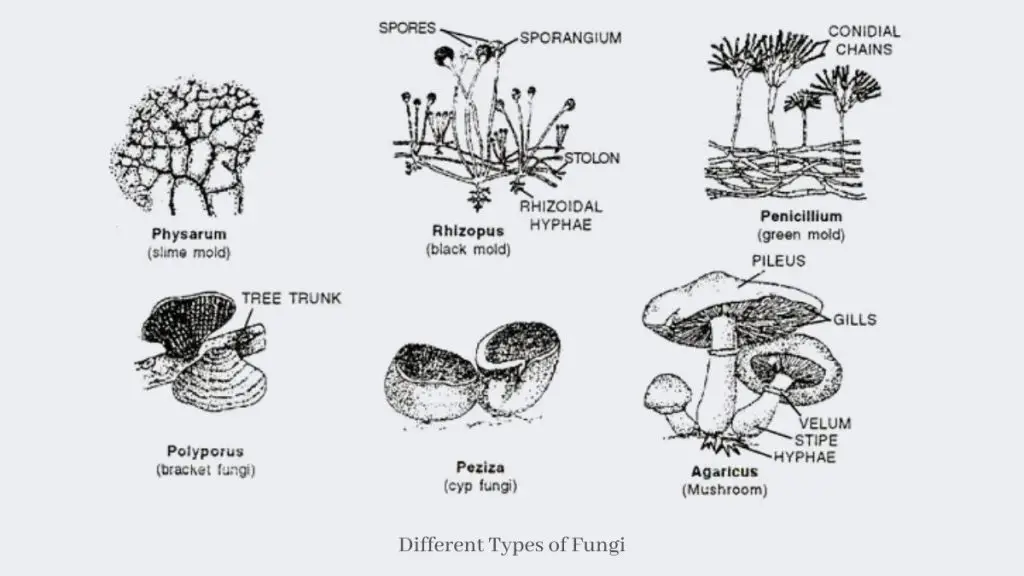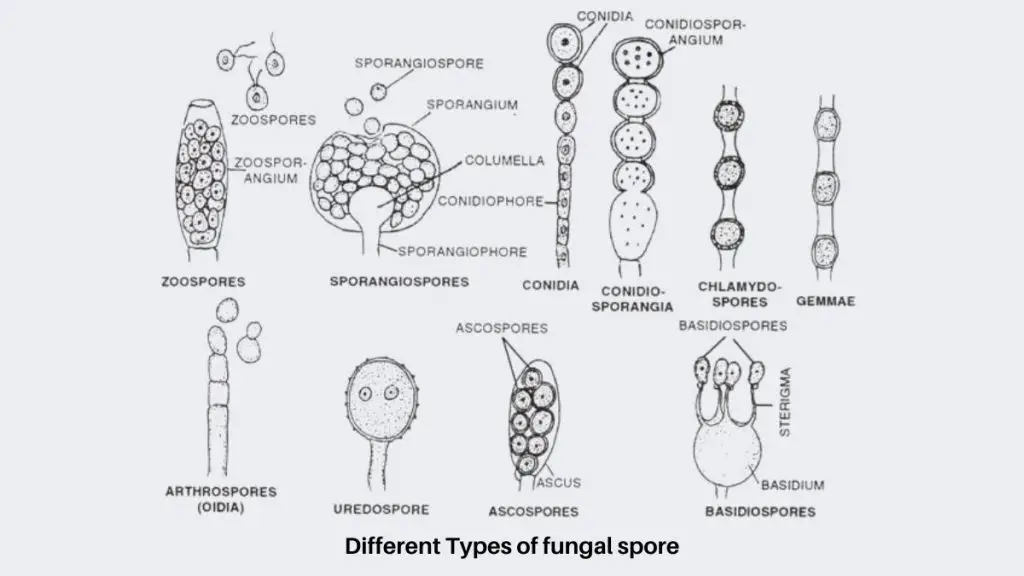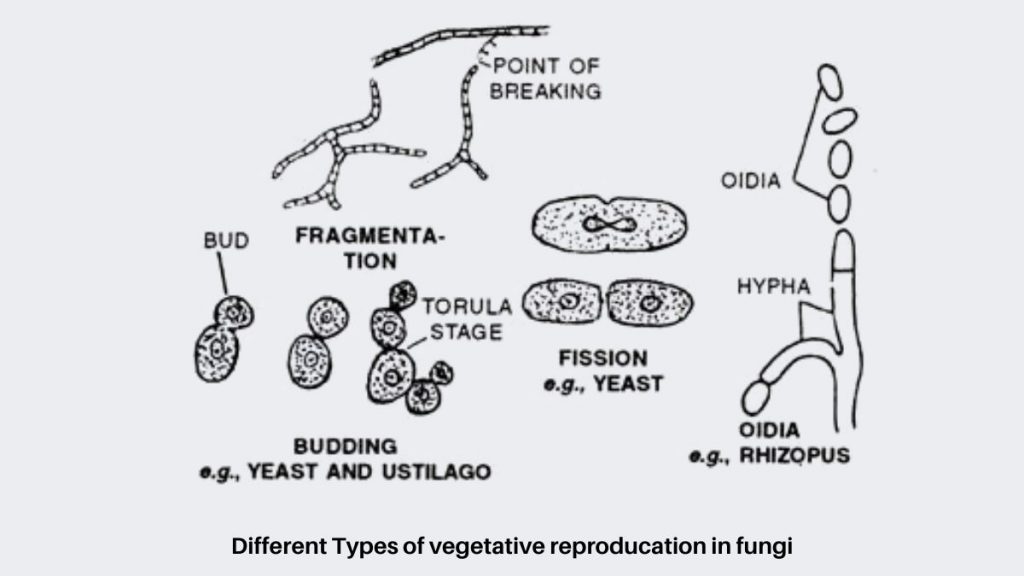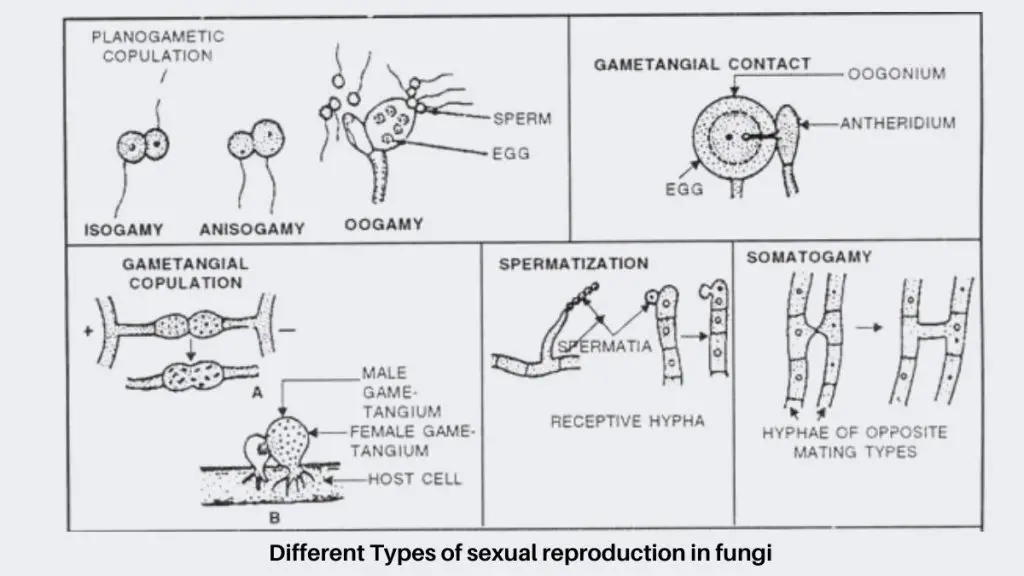In this article, we will learn about the Types of Fungi and Their Reproduction. There are present 5 types of fungi such as Chytridiomycota, Zygomycota, Glomeromycota, Ascomycota, and Basidiomycota. Fungi reproduce by vegetative, sexual, and asexual method.
The sexual reproduction is accomplished by the mating of haploid hyphae and form a diploid spore called a zygospore.
Classification/Types of Fungi
There are present different types of fungi. These fungi are classified based on their morphological structure of the mycelium spore formation, fruiting bodies and mode of life cycles.
The fungi are divided into five phyla such as: Chytridiomycota, Zygomycota, Glomeromycota, Ascomycota, and Basidiomycota.
Myxomycetes
- There are approximately 600 species of free-living slime molds. Now they are considered as consumer-decomposer protists or protistan fungi.
- They’re mostly found in damp places.
- They are also called myxamoeba because their thallus resembles to amoeba.
- Their entire thallus body transformed into a reproductive body, hence they are holocarpic.
- They follow both sexual and asexual reproduction methods. They accomplished their asexual method by fission or cysts and sexually by zoospores.
- There are two different forms of slime mould’s thallus such as acellular slime mould (plasmodium) and cellular slime mould (pseudoplasmodium).
- The wall-less mass of multinucleate protoplasm is known as plasmodium, such as: Physarum, Didymium, Fuligo etc. During maturity, they form capillitium, which is a stalked sporangia tilled with spores and a network of protoplasmic threads.
- The aggregate of individual amoeboid cells is known as pseudo plasmodium. Example: Dictyostelium.
Phycomycetes (Algal fungi)
- The lower fungi fall under this phyla. There are over 1700 species of Phycomycetes, most of them are aquatic and semi-aquatic.
- They have both unicellular and mycelial forms. The Mycelium form is aseptate and coenocytic.
- Sporangia forms asexual spores such as zoospores (ciliated) and aplanospores (non-ciliated).
- During sexual reproduction, two similar (isogamy) or dissimilar (anisogamy or oogamy) gametes are fused and forms zygospores.
- Examples: Mucor, Rhizopus, (bread mould), Albugo (cause white rust of crucifers) etc.

Ascomycetes (Sac fungi)
- They can be unicellular and multi-cellular fungi.
- There are over 30,000 species of Ascomycetes (Sac fungi).
- They develop asexual spore exogenously in form of chains known as conidia.
- They develop sexual spores in a sac-like ascus. These are endogenous ascosp ores.
- The fruiting body containing asci is called ascocarp.
- Examples: yeasts, Penicillium, Aspergillus, Clavicep (ergot fungi), Neurospora, Peziza.
Basidiomycetes (Club fungi)
- These include mushrooms, puffballs, rusts, smuts, toadstools etc.
- There are over 25,000 species of Basidiomycetes (Club fungi).
- They reproduced by sexual reproduction. Where they produce sexual spores known as basidiospores within the cells called basidia.
- The basidia is club-shaped, and basidiomycetes are also called club fungi.
- Examples: Agaricus (edible mushrooms), Puccinia (Rust fungi), Ustilago (Smut fungi), Polyporus (Bracket fungi), Candida etc.
Deuteromycetes (imperfect fungi)
- There are about 17,000 species of Deuteromycetes.
- They only have asexual or vegetative stages. There are different sexual structure of Deuteromycetes such as structures are synnema, pyenidia, accrvulii, sporodochium, etc.
- Except a few most of them are decomposers while others are saprophytes or parasites.
- They are mainly reproduced by the asexual method with the formation of conidia.
- Examples: Alternaria, Helminthosporium, Collectotrichum, Trichodenna etc.
Reproduction of Fungi
Fungi reproduced by vegetative, asexual, and sexual means. The asexual reproduction predominant which Depends upon the involvement of the entire thallus or a part of it, the fungi can be holocarpic or eucarpic.
Holocarpic fungi
In Holocarpic fungi, the whole thallus is converted into one or more reproductive bodies. The vegetative and reproductive phase does not occur at the same time in Holocarpic fungi.
Eucarpic fungi
In eucarpic fungi, only one part of the thallus develops reproductive organs whereas the remaining parts remain in the vegetative stage. Most of the fungi are Eucarpic in nature, where the vegetative and reproductive stages occur at the same time.
Vegetative Reproduction
In vegetative reproduction, one part of mycelium gets separated from the parent body and forms a new individual. The vegetative reproduction is accomplished by different methods such as fragmentation, budding, fission, sclerotia, rhizomorphs, and oidia formation.
The hyphae of Rhizopus and Coprinus is fragmented into many small fragments and then each of them gives rise to a new mycelium.
Asexual Reproduction

The Asexual Reproduction of fungi is accomplished by spores, either motile or non-motile, and form in a specialized part of mycelium. In asexual reproduction, fungi develop different types of spores such as zoospores, sporangiospores (=aplanospores), conidia, oidia (arthrospores), chlamydospores, gemmae, ascospores, uredospores, basidiospores etc.

Sexual Reproduction
Sexual Reproduction is accomplished by the formation and fusion of gametes. Except Deuteromycetes or fungi imperfecti, sexual reproduction is found in all groups of fungi.
Sexual reproduction is accomplished in three distinct phases such as plasmogamy (protoplasmic fusion), karyogamy (fusion of nuclei), and meiosis (reduction division of zygote).
Different Methods of sexual Reproduction in Fungi
(i) Planogametic copulation
In Planogametic copulation two gametes of opposite sex or strains are fused, where one or both of the fusing gametes are motile (flagellated). As a result of Planogametic copulation, it forms a diploid zygote.
Planogametic copulation is two type such as;
(a) Isogamy
In this process, the fusion occurs between two morphologically similar and motile but physiologically dissimilar gametes, which are produced by different parents
Example: Synchytrium.
(b) Heterogamy
In this process, the fusion occurs between two morphologically as well as physiologically different gametes. Heterogamy is divided into two classes such as Heterogamous reproduction is of two types: anisogamy and oogamy.
In Anisogamy the fusion occurs between two motile gametes where the male gamete is small and more active than the female gamete. Example: Allomyces.
In oogamy, the fusion occurs between the motile male gamete (antherozoid) with the large, non-motile female gamete (egg or ovum). Example: Monoblepharis, Synchytrium etc.
(ii) Gametangial contact
This method is accomplished between two gametangia of the opposite sex. In Gametangial contact, the male gametangium (antheridium) transfer it’s male nucleus or gamete into the female gametangium (oogonium) either through a pore or through a fertilization tube.
Example: Phytophthora, Sphaerothera, Alb. go, Pythium etc.
(iii) Gametangial copulation
In this method, the entire contents of two gametangia fused to form a common cell known as zygote or zygospore.
Example: Mucor, Rhizopus.
(iv) Spermatization
In this method, the fungi develop many minute, spore-like, single-celled structures called spermatia (nonmotile gametes). After that, these minute structures are transferred to either special receptive hyphae or trichogyne of ascogonium through the water, wind, and insects. The contents migrate into receptive structure. Thus dikaryotic condition is established.
Example: Puccinia.
(v) Somatogamy
In this method, the formation of the gametes is absent. The hyphae and their somatic cells are fused and form a dikaryotic cell.
Example: Agaricus, Peniophora etc.

gooo